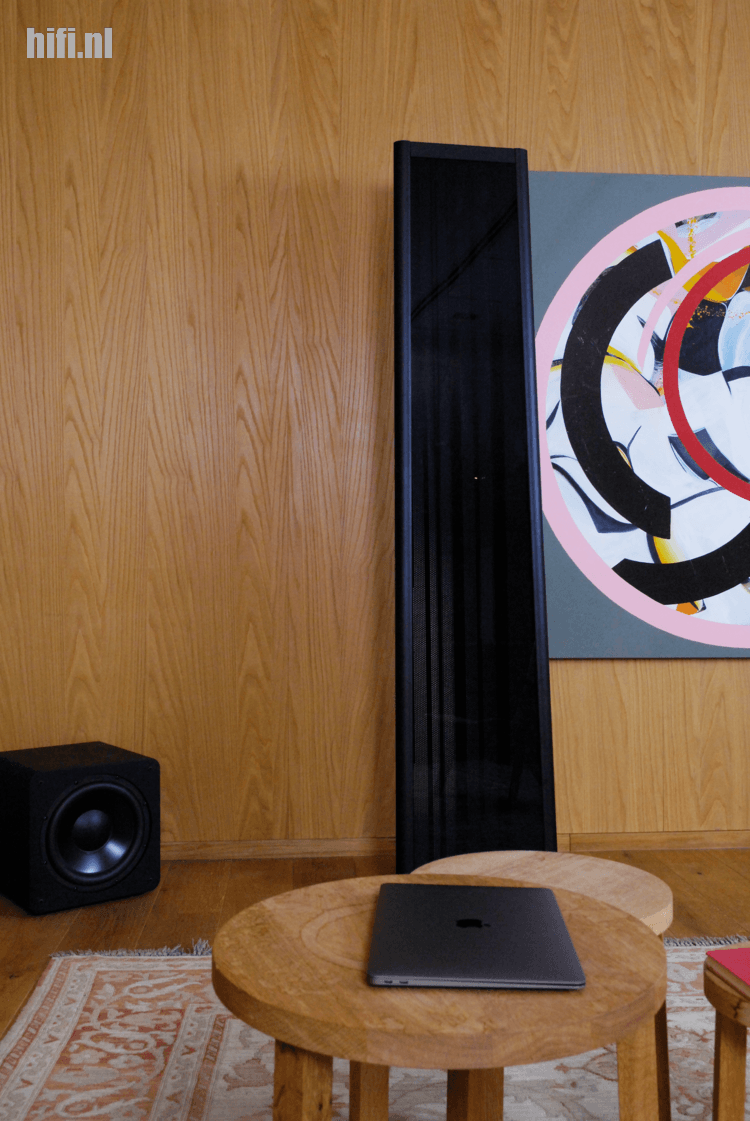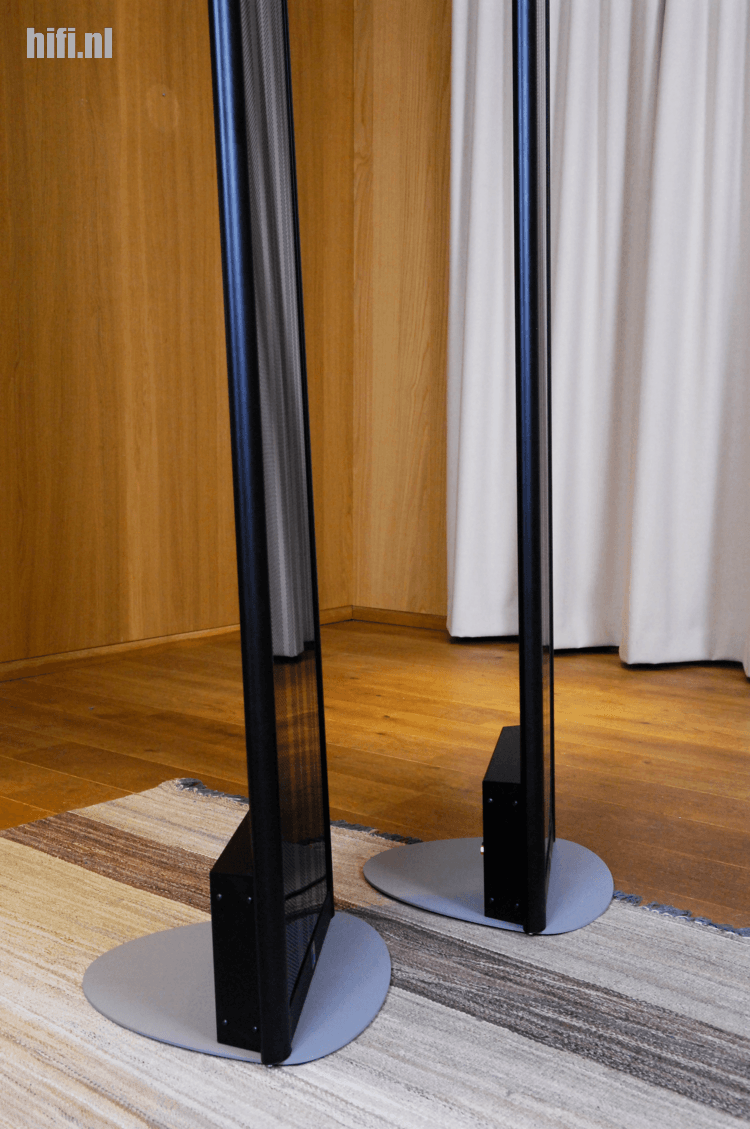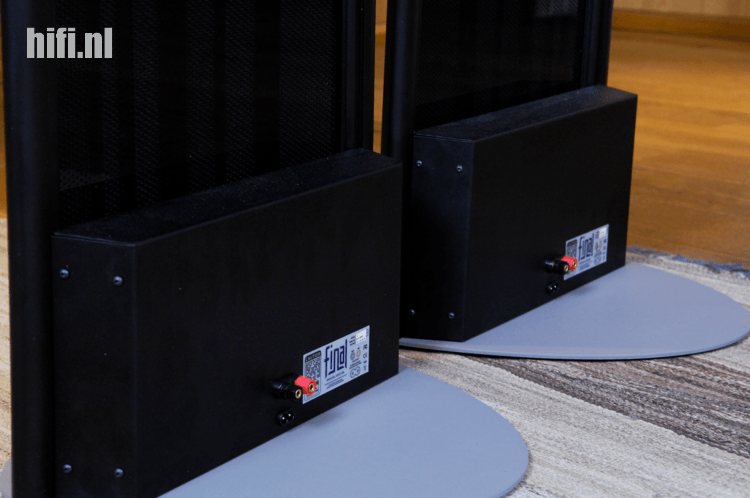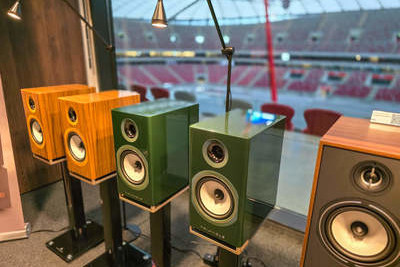
Final has launched a new series of electrostatic loudspeakers. It is a revolutionary step and certainly not an evolutionary continuation of earlier generations of models. At its core, Final is a highly innovative company that is constantly working to find solutions to the fundamental challenges inherent in the simple basic principles of an electrostatic panel. The new models actually distance themselves from what is on the market. Given the almost completely new technology, it is not unreasonable to speak about the electrostatic loudspeaker next level. A firm reason to listen to the current top model, being Model 15. Surprises await there. | Deze recensie in het Nederlands? Klik hier.
Final audio
Final was founded in 1989 by Maarten and Michiel Smits. The men left the company in 2004. Final recently restarted, again led by Maarten Smits. Electrostatic loudspeakers are a niche in the market. Technically, the electrostatic principle is simple, but to build a well-functioning and reliable electrostatic panel, there are quite a few complex challenges ahead. Few manufacturers can build electrostatic loudspeakers with any success. There are good models from Martin Logan, QUAD, Van Medevoort and Final. All these companies have found their own solutions to build these loudspeakers.
Fundamental challenges in the development of electrostatic drivers included the limited frequency range, the higher distortion, the decay of the membrane under the influence of light and pollution, and the effect that a good stereo image is obtained only at a narrowly defined listening position. The very first electrostatic loudspeakers had a stator and a membrane. But, the distance between the two always varies and that will bring distortion. This was solved by placing the membrane between two stators. The membrane then receives a fixed charge because of the fixed high voltage between the stators and the membrane. The stators mutually have a voltage that follows the sound signal. The force on the membrane in this configuration is proportional to the varying charge on the stators and the fixed charge on the membrane. The distortion then disappears. Later, the membrane’s deformation decreased even further due to the availability of thinner films. That membrane has a conductive layer. It is usually applied by hand and never has the same density per unit area. Since stators are in many cases made of steel and a steel plate is never really flat, the distance from the stator to the membrane is not constant. That does not contribute to a balanced sound with low distortion.
Ideal loudspeaker?
One question is why a consumer would like to have an electrostatic loudspeaker. This often leads to endless disputes, especially on the internet, about the advantages and disadvantages of all types of loudspeakers. That is actually a nonsense discussion. The ideal loudspeaker does not exist and the different loudspeaker types were initially developed within a professional market based on very specific application requirements. Contemporary discussions about this, within a previously barely present amateur and hobby-like user context, really lack that important essence. The horn loudspeaker was created at a time when large spaces, such as the cinema theaters in the 1930s, had to be filled with sound, while amplifiers at that time provided little more power than 20-50 watts. Line arrays are a solution to realize enormous sound pressure levels, whereby the decrease in sound per unit of length is less than with point sources. The sound is also easy to direct.
Ribbon drivers and magnetostatic elements were a response to the need to have loudspeakers that sound fast, neutral and detailed. Today's ribbon drivers can deliver 140dB sound pressure level, so are also used in public address systems. The question then arises why, after the 'hi-fi market' emerged in the mid-sixties, the cone speaker became dominant. Not because they were so good at the time, with the exception for professional systems from J.B Lansing, among others, but the cone speaker was just cheap and without too many technical problems. With the bass reflex trick, it was also possible to get low frequenties out of a small box.
The literature remains vague regarding the professional reasons behind the origin of the electrostatic loudspeaker. The principle of this loudspeaker was discovered and patented by Arthur Janszen in 1953. But the QUAD panels are actually based on an earlier patent from General Electric from 1934. Perhaps it is reasonable to assume that QUAD realized the first commercial application of the electrostatic loudspeaker. The literature does indicate that there were certainly two specific target groups and therefore reasons for the development. Namely the consumer who is mainly a music lover and the broadcasters and studios who wanted to use the QUAD as a professional monitor (BBC and Philips).
The advantages of the electrostatic loudspeaker for these target groups, which formed an important attraction early in history, were and are the neutrality, the speed, the spaciousness, the very low distortion and the lack of phase problems due to the lack of filters and the accompanying issues in the transition areas between the drivers. An electrostatic membrane has a low mass. So music can sound fast, neutral and detailed.
Innovation
A constant element at Final is the innovative ability to find "out of the box" solutions. Virtually no other manufacturer has introduced fundamentally new solutions to the aforementioned technical issues. The stators used to be made of metal, but Final uses PMMA plastic stators. This material is extremely flat, so the distance to the membrane is constant everywhere. In addition, the distance between the stators and the membrane can also be reduced. A conductive layer is applied to the inner side of the stator, but it can have different patterns. For example, different in width for the high, middle and low radiating areas. The sound-radiating surface then narrows in width. This removes the effect that an electrostatic panel only produces a good image at a single fixed listening position. With the new Final electrostatic loudspeakers, there is a "normal" stereo image, which remains virtually stable regardless of the listening position.
The conductive layer on the stator is applied using an inject print technology developed by Final. This gives an extremely even density of the applied material. Due to the flatness of PMMA and the uniformity of the conductive layer, the distortion is reduced even further. PMMA can be supplied in any conceivable color and can even be completely transparent. During demonstrations, Final would like to show a clear blue version of the Model 15. Together with the beautifully chromed frame, this is a huge eye-catcher. The PMMA material has a modern, trendy and extremely luxurious "look". It is also resistant to chemical decay. Metal stators are prone to oxidation. PMMA is also resonance free. In principle, a metal stator can resonate with the music. Since PMMA is not conductive, the user cannot receive an electric shock. Electrostatic panels operate at very high voltages. If a metal stator has a weak spot in the insulating paint layer, the user may receive a sensitive shock.
Final has also been innovative in the field of the membrane. Electrostatic panels used to have a Mylar membrane with a graphite coating. Final applies Teonex with a coating of Indium Tin Oxide. That is an aerospace material, is aging-free and stable in extreme conditions. Final has a very advanced technique to apply this coating to the membrane. During this process, the resistance per unit area can be determined. The membrane can thus be adapted to specific impedance requirements. The binder for this material blocks UV radiation. Tests at Final show that from 2012 this material does not show any kind of degradation. It is therefore no longer necessary to have a membrane replaced every six years.
Final Model 15

The Model 15 is for many enthusiasts of this principle and also for the undersigned the ultimate pièce de résistance. An almost full range electrostatic loudspeaker with the -3dB points at 45Hz and 23,000Hz. The panels are 203cm tall. The model is tapered and the panel dimensions give a bottom width of 36.6cm and 33cm at the top. Including frame, the base width is 43cm. With 18kg, this panel is very manageable. The frame is therefore made of aluminum. The tubes are slightly oval and not round. That gives a modern look. In the standard version, the frame is black and the same applies to the stators. A Model 15 stands on an aluminum colored base in the form of a flat plate. The plate has a depth of 40cm and is 43cm wide. The panel leans slightly backwards. There is a connection for direct mains supply. That is not done via an adapter. Two terminals (+ and -) connect the panel to an amplifier via a speaker cable. Given the very high level of finish of these panels, the loudspeaker terminals require replacement by somewhat more chic ones. Final advises to use amplifiers that can deliver an output power from 30 to 200 Watt. With an efficiency of 88dB, this Final can also be controlled with low power (tube) amplifiers.
Final claims that the new panels are virtually maintenance free due to the use of durable materials. These Finals therefore have a considerably longer service life. These panels are also energy efficient. If the music signal drops out, the high voltage switches off after a short time. As soon as a signal is applied again, the voltage switches on and the loudspeaker is immediately ready for use.
Performance
The former Final 1.4 was part of a group of reference loudspeakers in one of the listening rooms and especially in the studio, for about ten years. In those years, amplifiers such as the Jadis 200 and solid state electronics from Viola Labs (aka Cello) provided impressive performance. Those were examples of ideal combinations. Like the 1.4, the Model 15 can present an impressive low. This became clear during playing Fantasia and Fugue in G minor BWV 542, performed by Michael Murray. Nevertheless, Final indicated that combinations of Model 15 with subwoofers are being considered. The reproduction of the lower frequencies is sufficient for 85% of the music. If, for example, an octave comes down there, then there is an even more impressive system. That is particularly suitable for music friends who partially find their habitat between 16 and 30Hz.
Electrostatic loudspeakers, and in particular Model 15, are not marketing-inspired products built for the purpose of effect and intended to draw the visitor's attention in the 'wall of terror', being the wall of ‘switched’ loudspeakers at many hi-fi shops. An electrostatic driver has intrinsic qualities and presents the music in a way that often can be very realistic. Realism is not only dependent on the loudspeakers, but also on the electronics and recording. Before the Model 15 can be listened to properly, some playing time is required. The set arrived here directly from the production line. During playing, there are mainly changes in the low and middle frequencies.

Ultimately, the entire system then balances and reaches a spectacular performance level. The difference between a new and a played-in system is quite big. What stands out with the Model 15 is the phenomenal stage display. It is identical to that of high-quality dynamic systems. Depending on the recording, music can be heard far beyond both speakers. The reproduction is precise and has a very good focus. The stage remains very stable from almost any listening position. There is width and depth. The Model 15 sounds completely neutral. Neutral display is different from "cold and cool". If there are tonal qualities in a recording, it is communicated excellently. That neutrality means that it does take some preparation to find a good match with electronics and cables. Any deviation from a neutral sound, caused by electronics that sound sharp, a lesser recording or fancy designed cables, which lifts frequencies or just sounds mean because the architecture is not according to sound design principles, will all cause directly perceptible deviations. The Model 15 is merciless in that. If something is very good, you will notice. However, every error in the system or recording is also perceptible.
In the listening room is a very good match with the new Purify Eigentakt amplifiers. The cables used during the review are developed here from engineering materials that you will not often encounter in the consumer cable market. In principle, such a cable does nothing at all. Only let the sound through without adding or omitting anything and that is exactly the intention. But in the cable market for consumers are also decent and neutral cables that can fit perfectly in a system around this Final Model 15. Just try the Grimm Audio SQM interlinks. To assess the influence of (analog) cables, play some baroque works. The strings often sound spicy there, but with a good recording never it's never harsh or mean. The Model 15 can reproduce this music perfectly. However, the combination with cables and electronics really requires attention.
The Model 15 is a speaker on which you can play any kind of music. So it is not a speaker that would only be suitable for disco, classical or jazz. The Model 15 can also handle large orchestral works, organ concerts and modern dance music, although the lower frequencies expose less visceral impact in comparison with dynamic drivers. The Model 15 can definitely play big and powerful. But the added value of an electrostatic loudspeaker lies mainly in the quality of the low frequency reproduction. Those looking for subsonic thrills, in which physical objects in the listening room can be thrown around by the air displacement of the system, have a slightly too ambitious expectation pattern. However, apart from being suitable for most music, this Model 15 reproduces the midrange very beautifully. Voices take advantage of this, but also horns and the cello.
Much has been written about Todos Los Fuegos El Fuego by composer Maxim Shalygin (trptk 0050). The longer you listen, the more fascinating this work is. Listening to Death of a Mosasaurus, this contemporary work induces countless questions and thoughts. What exactly do you do to convert a story into sounds? Which sounds do you choose for moods and twists and turns? What is the function of the chosen melody? How is the relationship between story and music? Can you reconstruct a story line on an emotional level by listening to the music? Thoughts that occupy you for a long time. The Model 15 perfectly reproduces the sounds of the saxophones and keeps all those instruments neatly separated. This TRPTK release is an enormous challenge for an audio system. Speaking of the midrange, the voice of Johannette Zomer is of course entrusted to this great Final. Just listen to the Aria from BWV21 of the Channel Classics edition JUSTBACH (ccs 39917). With regard to voices and layer reproduction, the title track Encore un Soir by Céline Dion is spectacularly illustrated. A showpiece that demonstrates what the Model 15 is capable of. Things like dynamics, copper tone, a very good sounding grand piano and a growling bass come together on Brother Veal from the Wynton Marsalis Septet (Blue Interlude). Belonging to the best sounding compact discs you can have.
The system also convinces with orchestral work. The power and warmth from Anna Federova's masterly lecture of Rachmaninoff's Piano Concerto No.1 are beautifully and atmospheric. It goes without saying that such an electrostatic loudspeaker sounds fast and detailed. It is the speed and dynamics that make speaker systems sound realistic. The detailing is also excellent. It is a realistic level of detailing. No hyped detail, because the tweeter is set 2dB too high or the electronics accentuate the higher frequencies somewhere. Like all better audio systems, this configuration offers a lot of natural tranquility. Given that peace, freedom of distortion, dynamic powers and low distortion, it is wise to pay attention to the volume control. There is often a tendency to turn the sound too loud, while it is not experienced as such. A normal and standard monitoring level is around 75dB. You should keep this level when working in the studio, during mixing and mastering. If that deviates, then nothing will be right from your mix. In addition, hearing damage is lurking.
Hi-res experiment
Because of the qualities of the Final Model 15, it was subsequently used to experiment with an issue that the forums are boiling over. Precisely because the 15, together with distinctive electronics, is a loudspeaker with which things can be judged very well. There are countless people who claim that they can hear the difference between a CD recording (16 / 44.1) and a hi-res format loud and clear. So the undersigned is not and many professional studio engineers also question this. Scientific evidence showed that 16 /44.1 is enough to be able to listen to everything, but of course this article also produced some counter reactions.
A few years ago, large-scale research, based on 12,500 test cases, subsequently came to an interesting conclusion. Namely that there are actually very subtle differences, but that you have to be an extremely trained listener to perceive them and then you have to know exactly what to listen for. The study indicated that individuals who were intensively trained to listen to those differences became more successful in doing so. In any case, that conclusion settles with everyone who immediately shouts "yes, I immediately hear that this is a hi-res recording" during shows and demos. But what exactly are those things you should listen to? With that challenge, we listened to the Finals for a while and switched back and forth between program material with different resolutions. It will of course be clear that, if there are differences, that can be caused by technology or that the production process for a hi-res or CD master is slightly different. A CD version is made of a hi-res recording by means of a sampling converter. Then you may have the influence of a device and cables. However, the trick is to look for something "universal". Is there really a universal characteristic that says something about the difference and is caused by a difference in bit code, sampling rate and / or bit width? So there was an uncompleted search for that universal difference. It is not necessary to have a CD and a hi-res version of the same recording. You can just listen to CD music and hi-res recordings. Is there a universal difference somewhere that keeps coming back?
The investigation is still in progress here and it is too early to jump to conclusions. However, it is very difficult to discover such a universal difference. Still, the Finals show one or two aspects that keep coming back as being different between CD quality and hi-res. With a kind of temporary description about what those differences could be, attempts have been made to guess. Randomly choosing a track from a list with a mix of CD and hi-res recordings. As a result, there is a little more right guess than wrong, without immediately claiming to be a significant statistical difference. That requires very concentrated listening. Obviously all not yet very representative, but nice to play around with. The quality of the Finals challenges this kind of experiments. What at least becomes clear is that it is not very easy to perceive the difference between CD quality and hi-res. Even on a highly resolving system like the Model 15.
Epilogue
As with any loudspeaker principle, an electrostatic loudspeaker also has a recognizable signature. That is a thing of the past with this Model 15. Absolutely no longer recognizable as an electrostatic loudspeaker. But the specific advantages of this building principle have of course remained. An important attraction of larger speaker systems and therefore also of this Model 15 is in putting down a larger live stage but with a realistic image size. In a living room you therefore have the illusion of being present at a live performance.
Speakers like these Finals should preferably be free in the room. However, that can get in the way of other living functions. The beauty of the Model 15 is that you can quickly place it free standing in the room while listening. They can then stand flat against the wall when not in use. Due to the low weight, these systems can be moved very quickly. This is less easy to do so with a large dynamic system that often weighs 60+ kilos.

What really emerges is that this new Final takes a huge step forward compared to almost all other electrostatic loudspeakers. This is true innovation. The electrostatic principle has thus been taken to a new level that has not yet been shown. The Final Model 15 delivers an unimaginable live stage, with an uncanny focus, detailing and realism. Comparable to what the top of the dynamic systems does. That stage is solid and does not change if the listening position changes. As we continued the break-in period, the bass became more and more on par with the rest of the spectrum. The Final Model is quite critical towards electronics because of its high-resolution character. The right electronics don't necessarily have to cost a fortune. It was playing for a while with an eBay-sourced tube-system from the fifties which did not cost a fortune. One of the transcendental experiences in life.
However, if the match is correct, there is a system that plays with enormous transparency and phenomenal neutrality. But also a system that presents the atmosphere, warmth and glow from the recording in an impressive way. The Model 15 can perform dynamically unprecedented. Perhaps the physical experience and the pressure to be delivered is a fraction less than with the better dynamic systems. While the Model 15 can handle rough rock, the die-hards in this genre might be a little happier with systems that live on the borderline between hi-fi and public address systems. But all other music is played sublime. The undersigned has never been able to live only with electrostatic loudspeakers. As a reviewer, it is a luxury position to have different speaker types at hand. But the fact that these Finals were not put aside immediately after completing the review, and that it remains fascinating to listen to them every day, is significant. The Model 15 is a kind of desert island solution. One of the most advanced electrostatic systems available today and definitely the electrostatic loudspeaker next level.
Final audio Model 15
€ 12.598 per pair | final-audio.com





